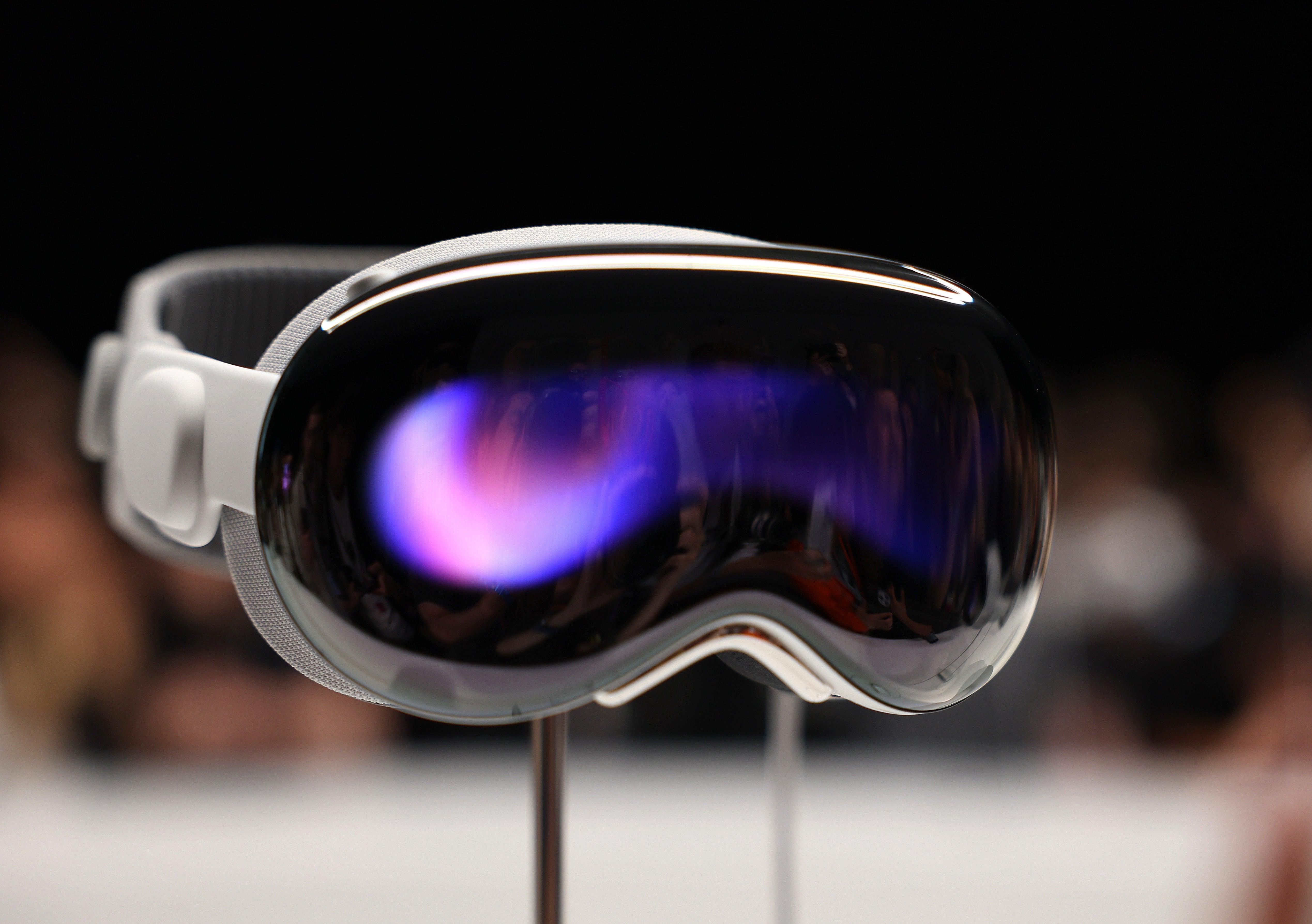The Apple Vision Pro is finally coming to the UK. But what is it for?
Apple’s futuristic augmented reality headset was unveiled a year ago. The tech and virtual reality experience is highly impressive, writes Andrew Griffin. But has Apple and its customers worked out what to do with it yet?


A year ago, during its Worldwide Developers Conference, Apple’s Tim Cook announced “one more thing”. He and his team had already introduced new features for iPhones, new Macs and many other new additions to its line-up. But here it was, as expected: the Apple Vision Pro.
Rumours had been flying around for years, and firmer reports had indicated much about the device for months in advance. As such, there were few surprises beyond the name, which had stayed largely secret. It was an augmented reality headset, it was very powerful and very expensive, and it was Apple’s next big product, though it wouldn’t be available for a while.
This February, it arrived, though only in the US. The first people got their chance to live with it. And despite some initial reports that more people than normal were returning their devices, the accuracy of which is unclear, it seemed a largely positive launch. Reviews were good, and at least some people were buying the headset, despite the high price tag.
People were spotted walking around with robot dogs while using it; some people were seen driving their Teslas with one on. (Again it’s not clear how organic those videos were, even if they did serve as very neat time capsules of early 2024.) People wrestled with how this new technology would fit in their lives, and the early answers were that it was great for getting work done and also for watching videos.
Then everything seemed to go strangely quiet. In the months since the headset was announced in early February, there were few new big breakthrough apps, and the viral videos that were both mocking of and astonished by the new technology seemed to die down. Apple’s “Newsroom” is fairly busy with posts, but there were only two devoted to Vision Pro: one about new spatial games in Apple Arcade, and another with a focus on the ways businesses were using the technology.
Then, last week, Apple announced another couple of mostly expected updates: it was releasing VisionOS 2, a new update to the software powering the headset, and that it will go on sale outside of the US for the first time. It will come to Asian countries including China first, at the end of the month, then to Australia, Canada, France, Germany and the UK a couple of weeks later.
It means that people in those countries will finally get a chance to try out the headset. (I recommend doing so, even if you have no plan of buying it; Apple will be rolling out similar demo experiences to those held in US stores in those new countries.) It may lead to a whole new round of excitement, jokes, questions and whatever else hit the headset the first time around.
But it’s also as good a time as any to ask: what is the Vision Pro now, a year since its announcement and four months since it launched? When it was first unveiled, Apple was clear that it was a spatial computer but also suggested that it wasn’t quite sure what that might mean in practice, and that it was built with a view to allowing the public to see where augmented reality might prove most useful.
The answer still isn’t quite clear. Apple’s own post about the Vision Pro bringing “a new era of spatial computing to business” does seem like one important hint, especially since Apple mentioned its use in enterprise during WWDC too. At $3,500, encouraging businesses to buy the headset for employees could be a good way of overcoming worries about the price.
But Apple will want to ensure that doesn’t mean it fading into a kind of enterprise irrelevance. Both Google Glass and Microsoft’s similar HoloLens ended up being pitched as business devices at their end, a fate that made it seem like the companies had given up on selling them to normal customers, before giving up on them entirely. So even if the Vision Pro does focus on professionals, it will hope that it’s work on the upcoming cheaper version – perhaps the Vision – will bring it back to everyone else.
Another answer could be Apple’s focus on content, which was a central part of this year’s update. Apple still doesn’t have huge amounts of video made for the Vision Pro, but it showed off some new films, and perhaps more notably revealed new work with film companies Canon and Black Magic that will make it easier for people to make their own. It is video that most people with the headsets – including Tim Cook, in interviews – point to as its central appeal.
As part of this year’s WWDC event, a year on, I had my second go in the headset. It was a reminder that my initial, astonished reaction may have been dramatic but wasn’t over the top; I haven’t been looking back on the year since the VisionPro was announced with rose-tinted goggles. It really is that amazing.
Yet the same question dogged that demo: what’s it all for? I watched videos (and they were just as immersive as promised) and used a mode that lets you rehearse your presentations onstage in Apple’s luxurious Steve Jobs Theatre (which was also astonishingly immersive, though in a way that induced a little bit of anxiety).
It was all brilliant, in every sense. But a year on, spatial computing still seems to be finding its place: is it a great work device, a cinema on your head, something that turns your front room into a gaming space or something else entirely? We’re still finding out, and even Apple doesn’t seem to quite know for sure.
At this year’s WWDC, Apple had another future to propose: AI. The two share more than the fact that they are two letters long and start with an A. Both are based primarily on the promise of technology that isn’t here yet. Both come with ethical concerns about the ways we understand and relate to our real world. And in both cases, Apple is insistent that they are doing it differently, refusing to use the more mainstream terms for each technology.
The focus on artificial intelligence (or Apple Intelligence) this year meant that augmented reality and the Vision Pro took something of a back seat. The updates to VisionOS were also relatively limited: you can now see your Mac on a bigger screen, and there are some neat updates to the way you navigate menus, alongside other features.
Now comes the hard part: finding the spots where spatial computing thrives, and where it might be useful. It might now be coming into view.
A version of this article appeared in the IndyTech newsletter. Subscribe here.





Join our commenting forum
Join thought-provoking conversations, follow other Independent readers and see their replies
Comments